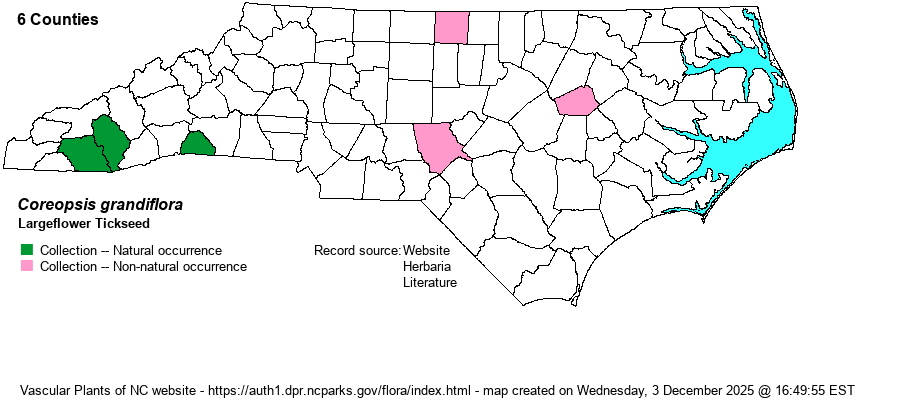| Author | Hogg ex Sweet | |
| Distribution | Southern Mountains as a native taxon; Piedmont and Coastal Plain as a non-native taxon. To date, found in only Caswell, Jackson, Macon, Moore, and Wilson counties. A specimen from Polk County (Melrose Mountain) is not visible for viewing on SERNEC, but the range and presumed habitat seem suitable for a natural site. Collections from other counties are likely misidentifications or introductions. The many reports on iNaturalist from downstate are not included on the map, owing in part to uncertainty of identification and partly to uncertainty of local provenance, though certainly none refer to natural/native populations.
Southwestern NC to GA, west to OK and TX for its presumed natural range. This species is widely cultivated, and thus its natural range is somewhat difficult to define, though most references treat it as native to NC. | |
| Abundance | Rare in the Macon and Jackson area of the southwestern Mountains, with five records in the NCNHP database. Extremely rare elsewhere (as a non-native taxon). This is a Significantly Rare species. | |
| Habitat | Rock outcrops, openings on montane slopes. "In thin soils of rock outcrops, especially granitic flatrocks and granite domes" (Weakley 2018). [None of the NC sites are on granitic flatrocks.] | |
| Phenology | Flowering and fruiting late May - late June. | |
| Identification | Characters that help identify this species are: leaves with distinct stalks (vs. sessile), leaves dissected into linear or threadlike segments, ray florets tipped with 4-5 blunt teeth, and disk florets dark yellow. The spread flower, from ray tip to ray tip, may reach nearly 3 inches across. | |
| Taxonomic Comments | There are several described varieties; see Weakley (2020) for identification and distributions. The taxon in the southern mountains is var. grandifloravar. harveyana, not native in the Atlantic states.
For excellent drawings of all species (except those recently described) and range maps (although now out-of-date), see the monograph by Smith (1976). | |
| Other Common Name(s) | Largeflower Coreopsis, Early Sunrise Tickseed | |
| State Rank | S1 | |
| Global Rank | G5 | |
| State Status | [SR-O] | |
| US Status | | |
| USACE-agcp | | |
| USACE-emp | | |

